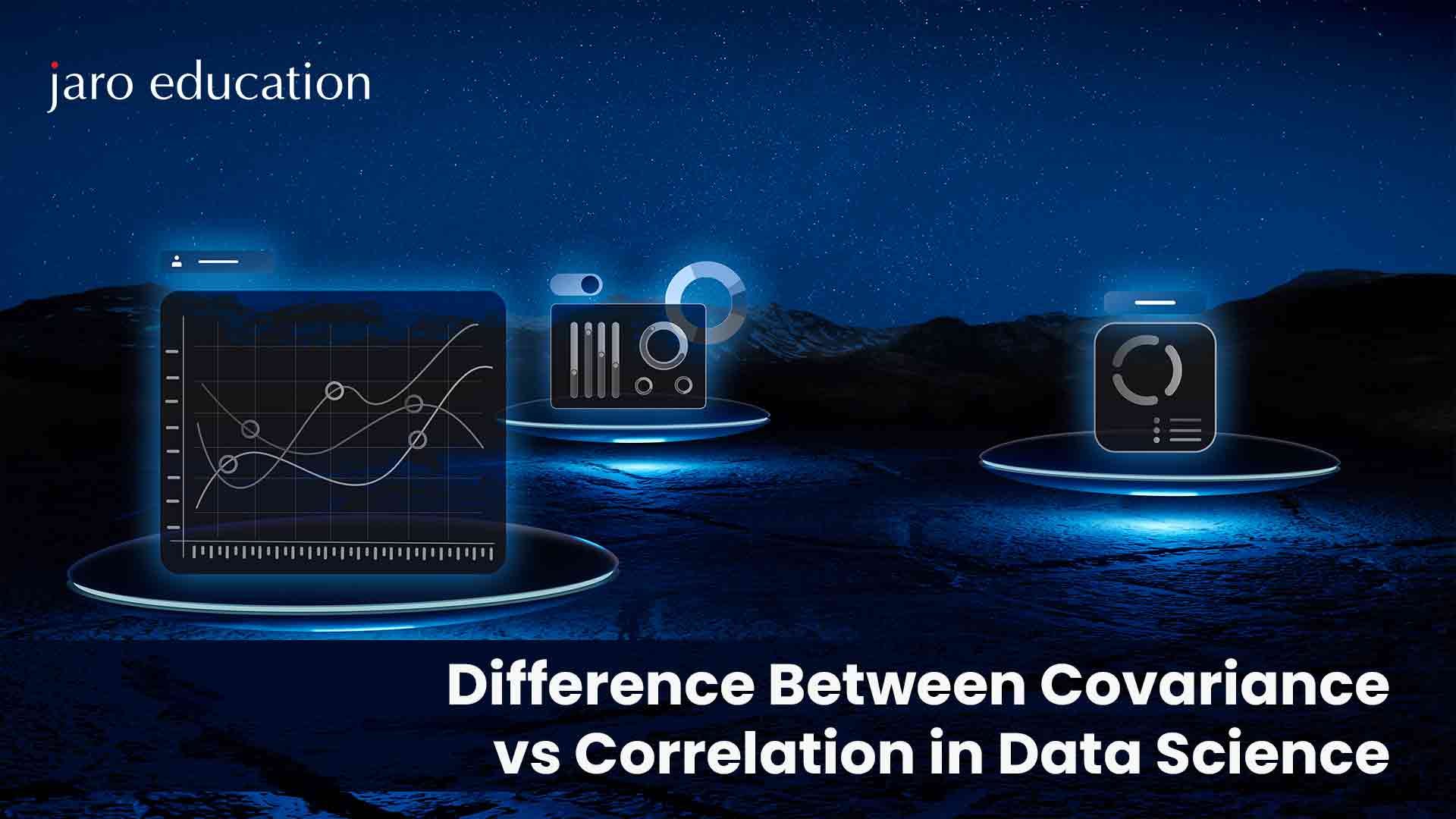
- jaro education
- 27, May 2024
- 5:56 pm
Introduction
Covariance and correlation are the two most crucial and basic statistics and probability concepts and they are also frequently occurring variables in statistical analysis as well as in various data science methods . Given their importance in the field of data science and analysis as well as their use in building high-utility machine learning models, you need to have a clear understanding of how the two depend on each other.
Covariance and correlation are two different concepts yet people still get confused and even use them interchangeably. Even though the difference between covariance and correlation may come across as very subtle or minimal, they can greatly impact the interpretation and utilisation of statistical relationships. This is why it is extremely important for any data scientist enthusiast or professional who works in the field of data analysis to understand the true nature of covariance and correlation to unveil the full potential of their data.
If you also wonder about the relationship and intricacies of both covariance and correlation, then you have come to the right place. This blog will give you a deeper understanding of the covariance vs correlation concept and how these two are different from each other. You will also learn the use and importance of these two in the field of data analytics.
Table of Contents
What is Covariance?
Covariance can be defined as a statistical term that exhibits a systematic relation or association between two random variables. In covariance, the change in one variable mirrors the change in the other one or we can also say that covariance implies that two variables are directly or inversely proportional.
Covariance Formula
The formula for covariance determines data points in a dataset from their average value. You can calculate covariance between variables using the formulas given below:
In the formula provided, the notations denote:
-
- xi = data value of x
- yi = data value of y
- x̄ = mean of x
- ȳ = mean of y
- N = number of data values.
The values of covariance denote the direction as well as magnitude (negative/positive) of the relationship between the variables. Moreover, these covariance values range from -∞ to +∞. A positive relationship is implied through a positive value, while a negative relationship is indicated through a negative value.
In covariance, the relationship between the variables becomes more reliant as the number value goes higher. Let us now understand zero, positive, and negative covariance.
-
Zero Covariance
-
Positive Covariance
-
Negative Covariance
What is Correlation?
Correlation can be understood as a statistical metric that calculates how closely two or more variables move in time. Correlation can be defined as an approach of statistics that is used to assess the relationship strength between continuous variables that are numerically measured. Correlated variables are those variables where the analogous movement of another variable mirrors the direction of one variable in some way throughout the examination of two variables.
Correlation shows off the strength as well as the nature of the relationship between variables. Some may even say that the values in correlation are standardised. However, covariance value cannot be used to measure how weak or strong a relationship is as there is no meaning to its magnitude.
The correlation value ranges from -1 to +1 where the maximum correlation value is +1 and it denotes that the two variables are completely connected positively, which means that the increase in one means the other will increase. If the correlation is -1 it denotes that the two variables are negatively correlated and if one rises the other will fall. If the correlation is zero it means the two variables are unrelated. The three types of correlation are:
-
Multiple correlation
-
Simple Correlation
-
Partial Correlation
What do they Measure:
Covariance is used to measure how a variation in one variable also results in variation in another variable. Whereas, correlation measures how strongly two variables are related to each other and the strength and direction of the relationship between the said two variables.Value Range:
Correlation, as well as covariance, are measures of linear association, the main difference is that coefficients in correlation are standardised and they exhibit an absolute value within a definite range from -1 to 1. While the values on covariance are not standardised with the use of an indefinite range from -∞ to +∞, making the covariance interpretation part somewhat tricky.Measurement Units:
Covariance is a unit-free measurement of the relationship between variables and therefore it is termed dimensionless. On the other hand, covariance is in units and is measured by multiplying the unit of one variable by the unit of another variable.Limitations in relationships:
Covariance analyse the linear relationship of only two variables in a particular data set, while in correlation two or more variables, data sets, and their linear relationships can be involved.Effects of Change in Scale:
The change in scale affects covariance. To explain it further, in covariance if the values of one variable are multiplied by a constant and the values of the other variable are also multiplied by the same or different constant, then the covariance is changed. On the other hand, there is no effect on correlation by the change in scale.How Do Covariance and Correlation Apply to Data Analytics?
- Both correlation and covariance are used in comparing samples from two or more different populations. This is an extremely important application as it helps in analysing the common trends and patterns in various samples.
- Before implementing statistical modelling, correlation is one of the key methods that is used in studying the relations between two variables.
- In data-driven industries, both covariance and correlation play an important role as they assist in identifying multivariate data so that data processing is done smoothly and analytical operations are also performed effectively.
- Multivariate analysis as well as feature selection in analytical processes is usually done by using covariance as well as correlation methods.
- Data scientists use Principal Component Analysis (PCA) in exploratory data analysis as well as predictive analysis. Principal component analysis is applied with the use of covariance and correlation so that the size of large datasets is made more manageable, which enhances its interpretability.
- Correlation is a vital tool used by analysts for feature selection in data exploration and pre-processing. Meanwhile, correlation is used in the investigation of relationships between variables, which is a strategy employed by analysts in feature selection.
Conclusion
This blog provides a deep insight into two key concepts: covariance and correlation. To summarise it all, covariance and correlation are the key tools to analyse and gauge the relationship as well as dependency between two variables. Hopefully, you now have a better understanding of these two statistical concepts and what is the major difference between covariance and correlation.
You have also learned how covariance and correlation are crucial tools in the field of data science and analytics. If you want to make a career as a data scientist, then you must enroll in Online Master of Science (Data Science) – Symbiosis School for Online and Digital Learning (SSODL). To get detailed information, click here.
FAQs
Q1. In brief, what are the major differences between covariance and correlation?
Ans: The major differences between covariance and correlation are:-
- Covariance values are standardised whereas correlation values are not standardised.
- Covariance denotes the direction of the linear relationship between variables whereas correlation is used to calculate the direction and strength of the linear relationship between two variables.
Q2. What are the similarities between correlation and covariance?
Ans: When it comes to statistics and probability theory, covariance and correlation can come across as quite similar.-
- Both covariance and correlation are used to measure the linear relationship between two variables.
- Both covariance and correlation concepts refer to how much a group or a single random variable might depart from its anticipated value.
Q3. Why correlation is selected over covariance to assess the relationship between variables?
Ans: Correlation is selected over covariance to assess the relationship between variables because it is unaffected by scale changes.Q4. What are the important points one must consider before choosing between covariance and correlation?
Ans: Before choosing covariance or correlation, you must keep the following into consideration:-
- Considerations for the research Question or objective
- Underlying assumptions and nature of the Variables
- Importance of standardised interpretation or comparison
- Availability of data and measurement scale
- Applicability in the specific analysis or field
Q5. How are correlation and covariance used in finance and portfolio management?
Ans: Both covariance and correlation are statistical tools that are used in a lot of fields including finance. Investors use them in stock markets to compare the stock returns of other companies and to inspect if there is any hidden correlation between them. This allows them to roughly estimate the future prices of stocks and to minimise investment risks. Correlation and covariance due to their practical application in understanding stock prices are also used by portfolio managers to select independent stocks.Q.6 What is the difference between correlation and causation?
Ans. People often confuse correlation with causation, however the statistical concepts differ from one another. Even if two variables are correlated it does not mean that one variable is the cause of change in the other variable. Correlation analysis is the relationship between two variables and there may be various factors that lead to the relationships. On the other hand, causation can be a reason for the correlation, however, it is not the only explanation.Q.7 What is the meaning of positive correlation?
Ans. In positive correlation, the value of one variable increases linearly as the value of another variable increases, symbolising a similar relation between both variables.Q.8 What is the meaning of the correlation coefficient?
Ans. A correlation coefficient can be defined as a statistical concept that is used to measure the strength between two variables.Q.9 How is the correlation coefficient determined?
Ans. To determine the correlation coefficient, first, you need to find the covariance of the variables, once that is done, divide the covariance by the product of the standard deviations of the variables. The result you get is the correlation coefficient.Q.10 How can I check whether a correlation is positive or negative?
Ans. To check whether the correlation is positive or negative, you first need to check the correlation coefficient value. It is a positive correlation, if the correlation coefficient value is higher than zero, while a negative correlation occurs when the coefficient value is less than zero. Finally, if the value of the coefficient correlation is zero, it shows a zero correlation.Q.11 What is the range of the correlation coefficient?
Ans. The value of the correlation coefficient lies between -1 to +1.Q.12 What is the meaning of 1 as well as -1 in correlation coefficient?
Ans. A coefficient correlation 1 refers to a perfect positive correlation, whereas correlation coefficient -1 refers to a perfect negative correlation.Q.13 What is the formula for Pearson’s correlation coefficient?
Ans. The formula for Pearson’s correlation coefficient is: ρ (X,Y) = cov (X,Y)/σX.σY.Q.14 What is the relationship between covariance and correlation coefficient?
Ans. Correlation is the normalised version of the covariance coefficient. This normalisation is done by dividing the covariance value by the standard deviation of the respective two variables.Q.15 What are the applications of correlation?
Ans. The various applications of correlation are:-
- The correlation matrix is used as a diagnostic tool in the verification process of other analyses. Let us understand this with an example, various correlations in linear regression indicate that the linear regression estimates would be incorrect.
- Correlation is of great help when dealing with huge volumes of data and analysts need to uncover patterns hidden in the data. The correlation matrix is also used to look for patterns in the data and to analyse if the variables are connected.
Q.16 How is the degree of freedom defined?
Ans. The degree of freedom is defined as the number of independent data points that are used to calculate the estimate.Q.17 What are the three different types of correlation?
Ans. The three different types of correlation are:-
- Simple correlation: Where a single number shows the extent of association between two variables.
- Partial correlation: Partial correlation reveals the relationship between two variables when the effects of one variable are eliminated.
- Multiple correlation: Multiple correlation can be defined as a statistical strategy that predicts the value of one variable while using two or more variables.
Q.18 What are the different covariance values?
Ans The different covariance values depict the ability of two variables to increase as well as decrease together about their mean values. These values can be positive, negative, or zero.-
- Positive covariance: This indicates that if the value of one or two random variables increases then the value of other variables will also increase.
- Negative covariance: This indicates that if the value of one or two random variables increases then the value of other variables will decrease.
Q.19 How is correlation applied in different business fields?
Ans. The applications of correlation in different fields are:-
- Finance: It is used to analyse the relationship between two stocks or a single stock and a market index.
- Marketing: It is used to analyse the relationship between two variables, such as the price of the product and the demand for the product.
- Healthcare: Analyses the relationship between two variables like the dosage of the drug and the effectiveness of the drug.
- Social Sciences: Analyses the relationship between two variables income and education.









